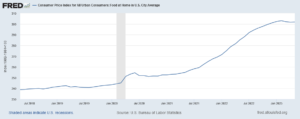June 13, 2023
It is always good to hear from real people who can put meat on the bones of dry economic data. For this reason, it’s great that the New York Times sought to interview some shoppers about how they are seeing food prices now that food price inflation has slowed sharply. Unfortunately, the people the NYT chose to interview were either very atypical or confused about their spending.
According to the Bureau of Labor Statistics (BLS), the cost of store-bought food increased by 23.5 percent from February 2020 to May 2023. For those interested in making a comparison, the average hourly wage for all workers in the private sector has risen 17.1 percent. Low-paid workers have done considerably better. The average hourly wage for production and non-supervisory workers in the low-paid leisure and hospitality sector (largely hotels and restaurants) rose by 25.2 percent.

Anyhow, the people interviewed for the NYT article reported far more rapid increases in the cost of their shopping baskets. The first person, an assistant high school teacher in Arlington, Va., reported that the cost of her groceries went from $70 a week before the pandemic to $100 a week now, an increase of 42.9 percent.
The second person, an accounting specialist at a nonprofit in Washington, reported that her bill had gone from $600 a month to $1000 a month. This is a rise of 66.7 percent. The third person giving their food bills, a management analyst at a federal agency, reported that two weeks of groceries now cost her $150, compared to $100 before the pandemic. This is an increase of 50 percent.
The increases in food bills reported by these three shoppers are far more than the increase shown by the Consumer Price Index (CPI). In fact, two of the three people report increases in the cost of their food basket that are more than twice the increase shown in the CPI. (The BLS reports that food prices in the DC metro area have risen just 15.3 percent since the pandemic.)
Of course, everyone’s consumption basket is different, and it is possible that these people actually have seen far more significant increases than the average for the country as a whole. It’s also possible that they misremember their pre-pandemic spending.
However, in either case, the NYT is not reporting experiences typical of shoppers across the country. Given what we know from the CPI, it should be as likely that we would find someone who has seen the cost of their shopping basket fall by 20 percent since the pandemic as we would find the accounting specialist with a 66.7 percent increase.
If the NYT could not find anyone whose experience seemed more in line with the data collected by the government, at the very least, the paper should have reported that these shoppers report seeing far higher food inflation than is calculated by the BLS.
This would be important information for readers to have. They should know that anyone who has seen the cost of their food basket rise by 66.7 percent is either very atypical or badly confused about how much they used to pay for food.







Comments